Serviços Personalizados
Journal
Artigo
Indicadores
-
 Citado por SciELO
Citado por SciELO -
 Acessos
Acessos
Links relacionados
-
 Citado por Google
Citado por Google -
 Similares em
SciELO
Similares em
SciELO -
 Similares em Google
Similares em Google
Compartilhar
Ingeniería y Universidad
versão impressa ISSN 0123-2126
Ing. Univ. vol.20 no.1 Bogotá jan./jun. 2016
https://doi.org/10.11144/Javeriana.iyu20-1.aiho
Acceptability of Implementing High Occupancy Vehicle Lanes on the North Highway in Bogota1
Aceptabilidad de la implementación de carriles vehiculares de alta ocupación en la Autopista Norte de Bogotá2
Luis Márquez3
Juan D. Aldana4
Mauricio F. Prieto5
1Scientific and Technological research article. Submitted: October 7th, 2014. Accepted on: September 15th, 2015. This article is derived from the SGI-643 project funded by the Research Directorate (DIN) with scientific support to the Research and Development Group Transportation Planning and Operating (GIDPOT) of the Pedagogical and Technological University of Colombia (UPTC).
2Artículo de investigación científica y tecnológica. Fecha de recepción: 7 de octubre de 2014. Fecha de aceptación: 15 de septiembre de 2015. Este artículo se deriva del proyecto SGI-643 financiado por la Dirección de Investigaciones (DIN), con el apoyo científico del Grupo de Investigación y Desarrollo en Planeación y Operación del Transporte (GIDPOT) de la Universidad Pedagógica y Tecnológica de Colombia (UPTC).
3Transportation and Highways Engineer. MSc Engineering emphasis on Transportation and PhD (c). Associate Professor, School of Transportation and Highways Engineering, Pedagogical and Technological University of Colombia (UPTC), Tunja, Colombia. E-mail: luis.marquez@uptc.edu.co
4Transportation and Highways Engineer, Pedagogical and Technological University of Colombia (UPTC), Tunja, Colombia. E-mail: aldanacolmenares@hotmail.com
5Transportation and Highways Engineer, Pedagogical and Technological University of Colombia (UPTC), Tunja, Colombia. E-mail: fernandoprieto@yahoo.es
How to cite this article:
L. Márquez, J. D. Aldana, and M. F. Prieto, "Acceptability of implementing high occupancy vehicle lanes on the North Highway in Bogota," Ing. Univ., vol. 20, no. 1, pp. 139-154, 2016. http://dx.doi.org/10.11144/Javeriana.iyu20-1.aiho
Abstract
This paper examines the acceptability of the implementation of a High Occupancy Vehicle (HOV) lane in the north of Bogota (Colombia), a strategy that is compatible with the policies of the mobility master plan of the city. Although the idea of using HOV lanes dates back to the 70's, it is still a valid alternative which is widely documented that produces positive impacts on travel times, accident rates, greenhouse emissions, among others. The study is based on discrete choice survey experiments which allowed calibrating a multinomial logit model. The calibrated model indicated that the acceptability of the HOV lane is very sensitive to travel times experienced by current car users. The model also identified the segment of the population with the highest acceptability for the proposal, which would consist of women over 31 years old, who travel for purposes related to work.
Keywords : high-occupancy vehicles; HOV lanes; car sharing; Bogota; urban congestion
Resumen
El presente artículo estudia la aceptabilidad de la implementación de un carril con vehículos de alta ocupación (VAO) en la autopista norte de Bogotá, estrategia que es compatible con las políticas del plan maestro de movilidad de la ciudad. Aunque la idea de utilizar carriles VAO se remonta a la década de los setenta, continúa siendo una alternativa vigente, ampliamente documentada, que produce impactos positivos en los tiempos de viaje, accidentalidad, efecto invernadero y emisiones. El estudio está basado en un experimento de elección que tomó información de preferencias declaradas para calibrar un modelo logit multinomial. El modelo calibrado indicó que la aceptabilidad de la medida es muy sensible a los tiempos de viaje que experimenten los usuarios actuales del auto. El modelo también permitió identificar el segmento de población con la más alta aceptabilidad, el cual estaría conformado por mujeres mayores de 31 años, que viajan por motivo trabajo.
Palabras clave : vehículos de alta ocupación; carriles VAO, auto compartido; Bogotá; congestión urbana
Introduction
The growth of motorization rates, high levels of traffic congestion, and the increase in fuel prices are phenomena that have motivated the study of policies to achieve a more rational use of transport systems [1]. While there is a wide range of alternative interventions, ranging from the traditional provision of more infrastructure to new measures of demand management, an option that comes with certain advantages is the implementation of High Occupancy Vehicle (HOV) lanes. This intervention has a greater degree of acceptance by users [2] and lower implementation costs when compared with other strategies of demand management such as road pricing schemes [3].
The use of HOV lanes is not a new idea. Its appearance dates back to the 70's and its basic concept is to give priority to higher occupancy vehicles in order to maximize the number of people who can mobilize through the road infrastructure [4] while minimizing the number of cars entering the central areas of cities. This management strategy has been extensively studied and documented in different countries like Australia [5], Austria [6], China [7], Greece [8], Spain [9], and the US [2], [10], [11], among others. In most documented cases no consensus on the positive impacts of implementing HOV lanes has been reached.
Chu [3] showed that the initial location of an HOV lane has a significant impact on the welfare of users, the location of these lanes on road corridors is desirable for the benefits they confer on both infrastructure users and society, to achieve a more efficient use of capacity. Fontes et al. [12], using a microscopic modeling platform to evaluate the operation of eco-lanes and HOV lanes on different types of infrastructure showed the feasibility of such strategies as well as positive impacts quantifying 2% reductions in travel time, reduction in emissions by 35-36%, and 36-39% in urban roads in suburban arteries.
In contrast to the benefits, some studies have also found negative environmental impacts, mainly due to the extremely high speeds sometimes reached in these lanes and the acceleration/deceleration that occurs on highways access/ egress, the contributions of which can range from 16-25% [13]. In the same vein, other studies have identified economic distortions [14] and problems of underutilization of installed capacity [11], which must be corrected. In summary, it can be said that the implementation of HOV lanes should be seen only as one of many measures needed to create a real sustainable solution for a city [6].
Based on their specific experiences, some cities have begun to propose variants and complementary strategies to increase the positive impact of HOV lanes and remedy some of the negative impacts. In California, for example, the policy to allow hybrid vehicles to use HOV lanes that allows to partly correct the problem of underutilization has been documented [15]; similar studies have been developed in intermediate European cities [12]. Another new proposal, which seeks to correct the distortions caused by differences in levels of congestion between different types of lanes, is the implementation of HOT lanes, i.e. HOV lanes that also allow lower occupancy vehicles to gain access to the lanes by paying a toll, as noted in [14].
In Colombia, unlike what has happened in other parts of the world, HOV lanes have not been implemented. However, among the policies of the mobility master plan for Bogota is the rational use of private cars taking into account the vehicle occupancy [16], suggesting the desirability of exploring strategies consistent with this policy. Recently, the city government implemented a measure on this basis, which is excluding from the vehicular restriction scheme those vehicles traveling with 3 or more passengers in the city center area [17]. Along the same lines, the expectation arises from studying the acceptability of a strategy to implement HOV lanes in Bogota.
Following a similar methodology to Bascuñán [18], this paper discusses the acceptability of implementation of HOV lanes on the North Highway in Bogota, a sector congested during peak periods that supplies sufficient infrastructure to allocate a lane exclusively for HOV. The findings have important policy implications for the city because users exhibit a willingness to share the car from the north to the downtown, which puts the strategic HOV lane as a potential alternative transport management for Bogota.
1. Methodology
The study was based on a choice experiment that was carried out by a stated preference (SP) survey applied in June 2013. The collected data allowed calibrating a multinomial logit model with which the acceptability of implementing an HOV lane was studied. The choice context, sample description, experimental design, and theoretical formulation of the model used are presented below.
1.1. Context
Bogota is the sixth largest city in Latin America, after Mexico D. F., Sao Paulo, Buenos Aires, Rio de Janeiro, and Lima. According to official projections for 2015, Bogota is expected to have a population of 7,878,783 inhabitants [19]. 27.0% of the resident population in the city has reached up to basic primary education; 36.7% reached high school; and 22.1% hold higher education studies and degrees. The resident population without any education is 4.1% [19].
The study was conducted in the area of influence of two city districts (Suba and Usaquén), characterized by the presence of middle and upper socioeconomic strata, as well as being those with a higher number of people traveling by car [20]. The North Highway was chosen as the location of the experiment, which runs about 22 km from the Heroes station between the districts Chapinero and Barrios Unidos, continuing north to the place called La Caro in the municipality of Chia. The road specifically studied was the North Highway between the 80th and 220th streets, as shown in Figure 1.
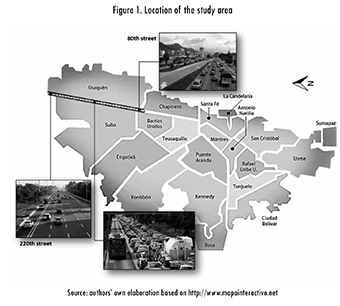
1.2. Sample Characterization
The sample size was determined for each experimental design parameter taking a 95% confidence level, as well as preliminary values estimated with a multinomial logit model and asymptotic standard error [21]. As the sample size was found to be very low (286 observations for the critical attribute, i.e. 72 individuals, since each respondent faced four choice sets), we decided to take a sample of 180 regular car users. With several observations from the same respondent it was possible to observe the behavior of each individual to choose different scenarios in order to identify those who always chose the same option (captives) and those who always chose the lowest cost alternative or shortest travel time (potentially lexicographical). By accepting the assumption that such individuals do not behave as maximizers of their utility, these comments were not part of the estimated models.
Thus, observations were discarded from 10 captive individuals or potentially lexicographical finally obtaining a sample composed of 170 valid questionnaires, corresponding to 680 pseudo-individuals, since each of the respondents was faced with four choices. Turnout was equitable with regard to gender, as a distribution of 52% men and 48% women was obtained. The most respondents were people over 31 years old (52%); this distribution is considered reasonable for individuals owning private cars in Bogota.
We found that most people were traveling to work (44%) and to study (28%). This large proportion of routine trips which can be difficult to postpone -as it is usually the case for traveling to work and study- can positively influence the decision to share the car. In addition, 36% of the sample said that travel time was excessive due to traffic congestion and they are inclined start their trips far in advance to avoid being late to the places where they were carrying out their activities, which meant for them decreasing their time allocation for other productive activities or leisure.
The survey showed that 20% of individuals had two or more cars; some users said that thanks to the second vehicle they could avoid the license plate restrictions that exist in the city. It was possible to detect a fraction of individuals who shared the car with co-workers or people of trust that had similar travel patterns. In addition, it was established that 68% of respondents knew about HOV lanes and knew the measure proposed by the district administration to exclude from the restriction of movement in the downtown area to vehicles that circulate with three or more people. About 57% of respondents agreed that a measure such as the HOV lanes would reduce congestion, while 41% also said the move could raise awareness and civic culture. Additionally, individuals highlighted a positive environmental impact that the measure could generate.
1.3. Choice Experiment
As usual in choice experiments based on SP surveys, first a focus group was conducted; next a pilot survey was applied to a sample of 30 people and, finally, the final experiment was prepared and implemented. The survey was structured into three parts: first the personal information of respondents was registered; the main features of the route taken were scored; and finally the list of stated preferences was introduced.
The choices were stated as follows: (1) car sharing to use the HOV lane, (2) use the Transmilenio (Bus Rapid Transit), and (3) use the car without sharing. Each alternative was characterized by three modal attributes: waiting time, travel time, and cost. The levels of each attribute were defined according to the average values observed in 2013, adjusted based on the focus group and the pilot survey, so that the experiment was sufficiently realistic and clear for individuals. The attributes and levels used in the SP survey are shown in Table 1.
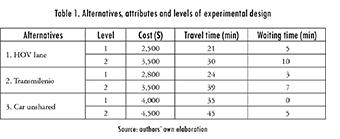
Following the recommendations of [22] it was found that 8 treatments were sufficient to study the main effects of the attributes. In addition, to avoid individual fatigue because of the cognitive load which they carry, it was decided to divide the experiment into two blocks, featuring four choices for each individual. Table 2 shows the choice situations that individuals faced in the experiment. As it can be seen, in organizing the choice situation facing the three available alternatives, individuals were able to find enough variation in levels to make the experiment credible and get good quality data for the estimation of choice models.
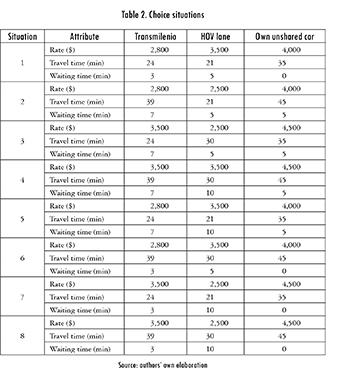
1.4. Model Used
The proposed methodology used logit models for analyzing the acceptability of an HOV lane in Bogota. In the multinomial logit model, assuming that the error terms distributed identically and independently, as per the Gumbel distribution, the probability that an individual n chooses alternative i, is given by:

Where Vnj is the representative or systematic utility. As in the present investigation, most of the discrete choice models currently use specified linear utility functions and it is considered that the β parameters are constant for all individuals, but may vary among the alternatives [23]:

To estimate the multinomial logit model a sample of N individual choices was observed, and the estimation by maximum likelihood was applied. Assuming that individuals' decisions are independent of each other, the log-likelihood function is written as follows:

Where Yni takes the value of 1 if the individual n chose the alternative i, and 0 otherwise. The calibration procedure allowed estimation of β coefficients, taking as estimators those values which maximize the log-likelihood of the sample [23]. Selecting the best model was based on the examination and comparison of some indicators such as consistency of signs, the significance of the estimators, measures of goodness of fit as the indexes p and p2 [24], and applying the ratio test, to compare more complex models against other simpler ones which can be obtained through linear restrictions [25].
Once the best model was chosen, it was used to study the choices in different scenarios and to measure elasticities with respect to different variables [23], estimating the change percentage for the probability of using an alternative i with respect to the change percentage change in a given variable:

Where βx is the estimated coefficient of the variable of interest, pni is the probability that the individual n decides to choose the alternative i, and Xi is the mean value of the variable.
The chosen model was also used to calculate the cross elasticities, i.e., the elasticity of pni with respect to a variable that enters the representative utility of alternative j:

Where,Ζnj is the attribute of alternative j as faced by person n and βz is its coefficient (or, if the variable enters nonlinear representative utility, then β z is the derivative of Vnj with respect to Vnj ).
2. Results
The results of the estimation models are presented in Table 3, which exhibits the four best fit models and a reference base model (MNL-0) that included only the attributes of the experimental design. As it can be seen, the specific constant of the new analyzed alternative was set to 0 because users have a better understanding of the current alternatives.
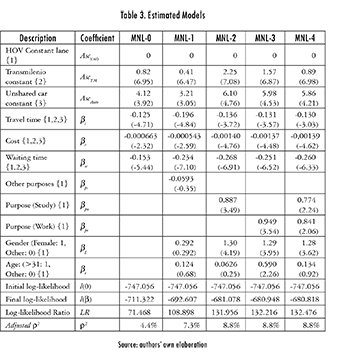
The design attributes, i.e. travel time, cost, and waiting time, were specified as generic attributes in the three utility functions. In the case of the variables associated with travel purpose and individual attributes (gender and age), the specification is made in the utility function of the new alternative to see with greater ease the effect that each of them produces on the choice of car sharing, given the existence of an HOV lane. Although the four models presented are of good quality, the MNL-3 model has been chosen as the best because achieves higher log-likelihood than MNL-2 for the same number of parameters. The MNL-1 and MNL-4 models were rejected because not all coefficients were significant at 5%.
Suspecting correlation between the alternatives HOV lane and car unshared, a hierarchical model specifying the presence of correlation between these two alternatives was considered. However, the parameter of the nest was not significant at 5%, which is why this model was not considered. Models with interaction between socioeconomic variables and both travel time and waiting time were also specified, but none of them showed good quality results. This means that given the data used and the specification models, no systematic variation was detected in the preferences of individuals.
The selected model indicates that women over 31 years old, who travel for work, would form the segment of the population that would most benefit from carpooling under the assumption that there was an HOV lane on the North Highway, between 80 and 220 streets. For this segment of the population, considering the average values of the design variables, an acceptability of 29.3% was found. At the other end would be men under 31 years old, traveling for purposes other than work, in which case the acceptability would be only 2.4%. The result found differs from the reference [26] as in this case both gender and age were found to have a significant effect on the car sharing preference, approaching instead to the results of [27].
The estimated model also yielded the subjective value of time (VST). It was found that individuals are willing to pay up to 95.6 COP/min (Colombian pesos) to reduce travel time and up to 183.2 COP/min to reduce the waiting time. The behavior of these values is considered reasonable when compared with the findings of [28]. The implications of this finding are important because the fact that there is a willingness to pay to reduce the travel time would make it possible to study the option of implementing a complementary charge system to the HOV lane as discussed in [14].
Acceptability was evaluated based on five scenarios: the first, assuming that congestion levels are reduced and as a consequence travel times of the alternative car unshared are reduced; the second, taking into account the average values of the attributes of the experimental design, and the last three, assuming the most critical conditions regarding traffic flow congestion. Everything else remained constant. Table 4, which summarizes the results of the simulation, shows how the acceptability of an HOV lane is very sensitive to travel time faced by current car users. Thus, the acceptability of the measure would be between 3.8% and 25.8% for the range of travel time between 35 and 55 minutes.
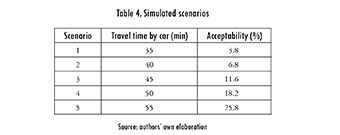
As Table 5 shown, high elasticities were found in the average levels of the design variables. In the case of wait time, an elasticity of-1.75 was found, while for travel time the elasticity was -3.11. The elasticity of travel time infers that to the extent that travel time is reduced by 10% in an HOV lane, the acceptability of the measure would increase to 31.1%. Also, a 10% reduction in the waiting time of the shared car would produce a 17.5% increase in the acceptability of the measure. The value found for the elasticity of travel time is considerably high when compared with that obtained by [29] for the demand of carpooling, which in the study was -1.47. However, it is necessary to note that in the sensitivity analysis conducted by [29] the elasticity of demand reached values of -7.00 for longer travel times, which is consistent with the model obtained.
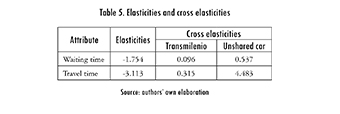
Cross elasticities were also estimated. Changes can be seen in the travel time in the alternative car without sharing that produce significant changes in the use of the other two alternatives. For example, having a cross elasticity equal to 4.4 means that a 10% change in travel time of the car without sharing involves a change of 44.8% in HOV lane use. It is important to note that the cross elasticities are the same for all alternatives i: a change in an attribute of alternative j changes the probabilities for all other alternatives by the same percent [23].
3. Conclusions
This paper achieved the objective of measuring the acceptability of the implementation of HOV lanes in the city of Bogota. The methodology seems to be easily transferable to other contexts where it would be desirable to do a similar analysis, for which it would be necessary to adjust the levels of experimental attributes according to the specific conditions of the choice context to study.
In the studied context, the model indicated that the acceptability of the HOV lane is very sensitive to congestion levels that current users experience themselves, reaching values between 3.8% and 25.8% for the simulated scenarios. The study also allowed the identification of the segment of the population with greater acceptance of the measure. This segment is comprised by women older than 31 years of age, who travel to work. In contrast, the segment of the population least willing to accept the HOV lane consists of men under 31 years old, traveling for purposes other than work. The evidence found would help the district administration to promote the measure in case it decided to implement it.
Direct elasticities indicate that travel time is a key attribute when evaluating the acceptability of the HOV lane. Although changes in waiting times have less impact on the use of HOV lanes compared with changes in travel time, waiting also has a significant effect on the acceptability of the alternative studied. The high cross elasticities of car travel time without sharing is an indicator of competition between alternatives, which also shows that changes in travel time of cars are very important in the use of HOV lanes. In contrast, the cross elasticities of travel time in Transmilenio indicates that alternative carpools do not compete strongly with public transport; in this case a 10% increase in travel time using Transmilenio produces only an increase of 3.15% on the acceptability of an HOV lane.
The analysis of the acceptability of HOV lanes on the main highway in the north of Bogota opens the possibility of some future research. First, it seems appropriate that after assessing the acceptability of the alternative it is pertinent to assess its impact, for which traffic modeling approaches can be used [8]. Also, since the traditional volume-delay functions seem inconvenient to study the effect of traffic congestion on these types of highways [30], another research topic arises concerning the analysis of the volume-delay function which is more appropriate to study the impacts on congestion that these types of strategies produce.
As noted in [14], it is possible that the implementation of HOV lanes produces a distortion because of the difference in traffic congestion levels between different types of highways, which implies the need to investigate how to correct these distortions, for example by implementing HOT lanes, i.e., HOV toll lanes. In this regard, it would be interesting to delve further into the best methodologies to determine the price for the use of such strategies, for such purpose line [31] can be followed.
Finally, if the studied strategy is implemented, it is considered important to study the perceptions of users specifying latent variables in the choice models. On this topic it is recommended adapting the methodology proposed by [32] using simultaneous estimation techniques as can be seen in [33].
References
[1] G. Santos, H. Behrendt, and A. Teytelboym, "Part II: Policy instruments for sustainable road transport," Research in Transportation Economics, vol. 28, no. 1, pp. 46-91, 2010. [ Links ]
[2] C. Wellander and K. Leotta, "Are high-occupancy vehicle lanes effective?: Overview of high-occupancy vehicle facilities across North America," Transportation Research Record,no. 1711, pp. 23-30, 2000. [ Links ]
[3] C. IP Chu, J. F. Tsai, and S. R. Hu, "Optimal starting location of an HOV lane for a linear monocentric urban area," Transportation Research Part A: Policy and Practice, vol. 46, no. 3, pp. 457-466, 2012. [ Links ]
[4] K. F. Turnbull, An assessment of high occupancy vehicle (HOV) facilities in North America: executive report".Washington D. C.: U.S. Department of Transportation, 1992. [ Links ]
[5] J. Bauer, C. McKellar, J. Bunker, and J. Wikman, "High occupancy vehicle lanes - anoverall evaluation including Brisbane case studies," presented at Proceedings 2005 AITPM National Conference, pp. 229-244. [ Links ]
[6] W. J. Berger, "The Austrian HOV-lane: experiences in implementation and operation," Journal of Civil Engineering and Management, vol. 8, no. 4, pp. 255-262, 2002. [ Links ]
[7] R. Wang, "Shaping carpool policies under rapid motorization: the case of Chinese cities," Transport Policy, vol. 18, no. 4, pp. 631-635, August 2011. [ Links ]
[8] I. Stamos, G. Kitis, S. Basbas, and I. Tzevelekis, "Evaluation of a high occupancy vehicle lane in central business district Thessaloniki," Procedia - Social and Behavioral Sciences, vol. 48, pp. 1088-1096, 2012. [ Links ]
[9] T. Geerken, "Madrid high occupancy vehicle (HOV) lanes," in SCP Cases in the Field of Food, Mobility and Housing, S. Lahlou and S. Emmert, Ed. Paris: Workshop of the Sustainable Consumption Research Exchange, 2007, pp. 327-334. [ Links ]
[10] J. Obenberger and B. Rupert, "Operating high-occupancy vehicle lanes: issues for consideration," Transportation Research Record, no. 1711, pp. 6-12, 2000. [ Links ]
[11] J. Kwon and P Varaiya, "Effectiveness of California's high occupancy vehicle (HOV) system," Transportation Research Part C: Emerging Technologies, vol. 16, no. 1, pp. 98-115, February 2008. [ Links ]
[12] T. Fontes, P. Fernandes, H. Rodrigues, J. M. Bandeira, S. R. Pereira, A. J. Khattak, and M. C. Coelho, "Are HOV/eco-lanes a sustainable option to reducing emissions in a medium-sized European city?," Transportation Research Part A: Policy and Practice, vol. 63, pp. 93-106, May 2014. [ Links ]
[13] K. Boriboonsomsin and M. Barth, "Impacts of freeway high-occupancy vehicle lane configuration on vehicle emissions," Transportation Research Part D: Transport and Environment, vol. 13, no. 2, pp. 112-125, March 2008. [ Links ]
[14] H. Konishi and S. Mun, "Carpooling and congestion pricing: HOV and HOT lanes," Regional Science and Urban Economics, vol. 40, no. 4, pp. 173-186, July 2010. [ Links ]
[15] K.S. Nesamani, L. Chu, and W. Recker, "Policy Implications of Incorporating Hybrid Vehicles into High-Occupancy Vehicle Lanes," Journal of Transportation Systems Engineering and Information Technology, vol. 10, no. 2, pp. 30-41, April 2010. [ Links ]
[16] Secretaría Distrital de Movilidad, "Decreto 319 de 2006," Marzo 2014 [Online]. Avalaible at: http://www.movilidadbogota.gov.co/hiwebx_archivos/ideofolio/Decreto319de2006_11_4_7.pdf [ Links ]
[17] Alcaldía Mayor de Bogotá, "Decreto 575 de 2013," Marzo 2014 [Online]. Avalaible at: http://www.alcaldiabogota.gov.co/sisjur/normas/Norma1.jsp?i=55963 [ Links ]
[18] R. T. Bascuñán, "Preferencias declaradas en el análisis de la aceptabilidad de la tarificación vial para la ciudad de Santiago," Tesis (Magíster en Ciencias de la Ingeniería) Pontificia Universidad Católica de Chile, 2009. [ Links ]
[19] Departamento Nacional de Estadística, "Estimación y proyección de población nacional, departamental y municipal por sexo, grupos quinquenales de edad y edades simples de 0 a 26 años 1985-2020," Marzo 2014 [Online]. Avalaible at https://www.dane.gov.co/index.php/poblacion-y-demografia/proyecciones-de-poblacion [ Links ]
[20] Secretaría Distrital de Movilidad, "Formulación del plan maestro de movilidad para Bogotá D.C., que incluye ordenamiento de estacionamientos, Transporte Público-V8," Marzo 2014 [Online]. Avalaible at http://www.movilidadbogota.gov.co/hiwebx_archivos/ideofolio/08-TransportePublico_15_9_24.pdf [ Links ]
[21] M. Bliemer and J. M. Rose. "Efficiency and sample size requirements for stated choice experiments," presented at 88th Annual TRB Meeting, Transportation Research Board, Washington, DC, January 2009, p. 11. [ Links ]
[22] G. Koçur, T. Adler, and W Hyman, E. Audet. Guide to Forecasting Travel Demand With Direct Utility Measurement. Washington: USA Department of Transportation (UMTA), 1982, pp. 197-214. [ Links ]
[23] K. Train, Discrete Choice Methods with Simulation. Cambridge: Cambridge University Press, 2003. [ Links ]
[24] J. D. Ortúzar and L. G. Willumsen, Modelling Transport. 4th edition. Chichester: John Wiley & Sons, 2011. [ Links ]
[25] M. Ben-Akiva and S. R. Lerman, Discrete Choice Analysis: Theory and Application to Travel Demand. Cambridge: The MIT Press, 1985. [ Links ]
[26] G. Correia and J. M. Viegas, "Carpooling and carpool clubs: Clarifying concepts and assessing value enhancement possibilities through a Stated Preference web survey in Lisbon, Portugal," Transportation Research Part A: Policy and Practice, vol. 45, no. 2, pp. 81-90, February 2011. [ Links ]
[27] D. Brownstone and T. F. Golob, "The effectiveness of ridesharing incentives: discrete-choice models of commuting in Southern California," Regional Science and Urban Economics, vol. 22, no. 1, pp. 5-24, 1992. [ Links ]
[28] L. Márquez, "Disposición a pagar por reducir el tiempo de viaje en Tunja, Colombia: comparación entre estudiantes y trabajadores con un modelo Logit mixto," Lecturas de Economía, no. 78, pp. 46-72, enero-junio 2013. [ Links ]
[29] F. Ciari, "Sharing as a key to rethink urban mobility: Investigating and modeling innovative transport systems," Thesis (Doctor of Sciences) Environmental Engineer, University of Florence (Italy), 1974. [ Links ]
[30] X. Zhang, W Wang, S. Chen, and Z. Li, "Research on the link travel time model for high occupancy vehicle lanes of freeways," Procedia - Social and Behavioral Sciences, vol. 96, 6, pp. 1728-1737, November 2013. [ Links ]
[31] K. Jang, K. Chung, and H. Yeo, "A dynamic pricing strategy for high occupancy toll lanes," Transportation Research Part A: Policy and Practice, vol. 67, pp. 69-80, September 2014. [ Links ]
[32] R.C. Jou, M. C. Weng, and C. C. Chen, "The evaluation of high occupancy vehicle lanes on Sun Yat-Sen freeway in Taiwan," Journal of Advanced Transportation, vol. 39, no. 2, pp. 169-192, 2005. [ Links ]
[33] L. Márquez, V Cantillo, and J. Arellana, "How are comfort and safety perceived by inland waterway transport passengers?," Transport Policy, vol. 36, pp. 46-52, November 2014. [ Links ]














